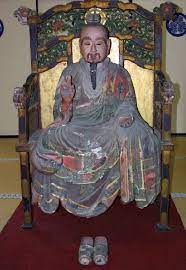The Motley Bodhisattva
(I was taken with this brief article in John Wu’s Golden Age of Zen. It offers a taste of the teacher Fudaishi. He is credited with the invention (some articles make sure we understand this is highly unlikely) of a library table for ease of access to the Tripitaka. In Buddhist mythology he becomes the patron and protector of libraries.
He was a householder practitioner and a master of the Way. The anecdote about the sermon is captured as case 13 in the Blue Cliff Record. And those who follow the Harada Yasutani koan curriculum will see several of the brief cases in the Miscellaneous collection in his verses.
Zen, of course, is a Buddhist school. And. But. There are are two other facts on the ground. One is that Zen emerges in a culture with rich religious traditions, Taoism and Confucianism. And we can see the influences of these traditions, Confucianism with Zen’s emphasis on lineage, and Taoism with Zen’s development of koans. For instance.
Another is that Zen ultimately is not owned by any religion. The word Zen, Chan in Chinese, means meditation, and Zen is a Buddhist school emphasizing meditation. And Zen colloquially is understood as awakening. Awakening takes specific forms, but isn’t actually too particular as to what those forms must be. The rise of Jewish and Christian Zen masters in the West arguing that point rather forcefully.
So, in honor of the mess, and for those who for various reasons find themselves inbetween, this little offering…
JIF)
The Bodhisattva Shan-hui, better known as Fu Ta-shih, born in 497, was one of the most extraordinary figures in Buddhism and an important precursor of the School of Zen. Once he was invited by Emperor Wu of Liang (who reigned from 502 to 549) to give a lecture on the Diamond Sutra. No sooner had he ascended to the platform than he rapped the table with his rod and descended. The poor emperor was simply lost in amazement. Yet Shan-hui asked, “Does Your Majesty understand?” “I don’t understand at all,” replied the emperor. “But the Ta-shih has already finished his sermon!” Shan-hui remarked.
On another occasion, as Shan-hui was delivering a sermon, the emperor arrived, and the whole community rose to show their respect. Only Shan-hui remained seated without any motion. Somebody took him to task, saying, “Why don’t you stand up when His Majesty has come?” Shan-hui said, “If the realm of the Dharma is unsettled, the whole world would lose its peace.”
One day, wearing a Buddhist cassock, a Taoist cap, and Confucian shoes, Shan-hui came into the court. The emperor, amused by the motley attire, asked, “Are you a Buddhist monk?” Shan-hui pointed at his cap. “Are you then a Taoist priest?” Shan-hui pointed to his shoes. “So, you are a man of the world?” Shan-hui pointed to his cassock.
Shan-hui is said to have improvised a couplet on the occasion:
道冠儒履佛袈裟 With a Taoist cap, a Buddhist cassock, and a pair of Confucian shoes,
會成三家作一家 I have harmonized three houses into one big family!
If, as Suzuki so well says, Zen is the “synthesis of Taoism, Confucianism, and Buddhism applied to our daily life as we live it,” the tendency was already prefigured in Fu Ta-shih.
Two gathas from Fu Ta-shih have been frequently quoted by Zen masters. One reads:
空手把鉏頭 Empty-handed, I hold a hoe.
步行騎水牛 Walking on foot, I ride a buffalo.
人在橋上過 Passing over a bridge, I see
橋流水不流 The bridge flow, but not the water.
The other reads:
有 物先天地 Something there is, prior to heaven and earth,
無形本寂寥 Without form, without sound, all alone by itself.
能 爲萬象主 It has the power to control all the changing things;
不逐四時凋 Yet it changes not in the course of the four seasons.
**
Chapter XIV/26. In: The Golden Age of Zen, Taipei: The National War College in co-operation with The Committee on the Compilation of the Chinese Library, 1967, pp. 253-254.













